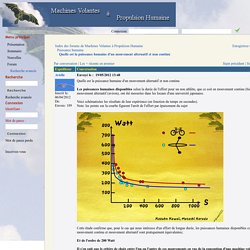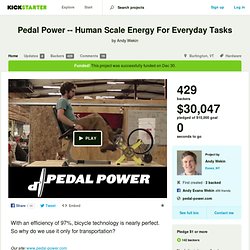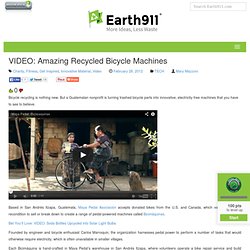

Pedal powered water pumps, threshers, blenders, tile makers and more. What Are Bicimáquinas?

Bicimáquinas are pedal-powered machines that assist with a variety of jobs in the home, on the farm, on the road and in small businesses. Each bicimáquina is handmade in our workshop using a combination of old bikes, concrete, wood, and metal. So far, we have developed several original designs that have proven to be both functional and economical. We have produced fact sheets and instructions for the more popular designs. We also have some Sketchup models. Bicycle Mill/Corn Thesher This bicycle machine is adapted to fit a hand powered grinding mill or a corn thresher. The Thresher is used post-harvest and easily degrains 12 to 15 quintales (1 quintal = 100 lbs.) per day and requires only one person to operate the machine. Bicycle Blender A common kitchen blender adapted to a converted bicycle. Bicycle Rope Water Pump The Mobile Water Pump Fits on a bike and can be taken anywhere. Hand-Powered Blood Centrifuge.
Here’s how to build a whirligig: Thread a loop of twine through two holes in a button.

Grab the loop ends, then rhythmically pull. As the twine coils and uncoils, the button spins at a dizzying speed. Go to the web site to view the video. Video by Kurt Hickman Inspired by a toy, Stanford bioengineers have developed an inexpensive, human-powered blood centrifuge that will enable precise diagnosis and treatment of diseases like malaria, African sleeping sickness and tuberculosis in the poor, off-the-grid regions where these diseases are most prevalent. Now, using the same mechanical principles, Stanford bioengineers have created an ultra-low-cost, human-powered centrifuge that separates blood into its individual components in only 1.5 minutes.
“To the best of my knowledge, it’s the fastest spinning object driven by human power,” said Manu Prakash, an assistant professor of bioengineering at Stanford. No electricity required The other string theory.
Category:CCAT pedal powered innovations. Forum - Puissance humaine - Quelle est la puissance humaine d'un mouvement alternatif et non continu : Machines Volantes à Propulsion Humaine. Il me semble qu'il faut distinguer le mouvement et l'effort.

Par expérience personnelle de cycliste et de coureur de fond long, le seul moyen de faire un effort de longue durée est que le muscle sollicité travaille un certain temps et doit se reposer au moins aussi longtemps!! Je n'ai pas d'expérience d'aviron à haute dose, mais j'ai l'impression que l'on retrouve les mêmes conditions: traction le plus longtemps possible et retour. Pendant le retour, les muscles "tracteurs" se reposent. En conséquence, même sur un vélo, la sollicitation musculaire est alternative: pour abaisser la pédale certains muscles se contractent et d'autres interviennent pour remonter la pédale (essayez de pédaler avec une seule jambe et un cale pied). J'explique la puissance supérieure du vélo à l'aviron parce qu'il n'y a pas de temps "mort' (le cycliste "tire" sur la pédale) alors que le retour est passif sur les rames.
Selon moi 200 W reste très largement optimiste. Alternative Energy - Pedal Power. Amateur - Culticycle pedal power tractor. Pedal Power - Human Scale, Multifunction, Pedal Powered Machines. Wallaby - Human Dynamo. Windstream Power - Human Power Generators. Kickstarter - Pedal Power. Our site: www.pedal-power.com The bicycle is one of the most ubiquitous and indispensable technologies ever developed.

It is efficient, elegant, environmentally friendly, fun, healthy, inexpensive, and user-maintainable. It is a human scale means of travel that increases our range and speed ten-fold — yet we only use its core technology for transportation even though it is suitable for performing a multitude of tasks. For the past five years, we have designed and built stationary pedal-powered machines (dubbed “dynapods” by Alex Weir). In addition to several custom dynapods, we have developed two core products: 1) the Big Rig, a multifunction machine with a built-in seat and work surface, and 2) the Pedal Genny, a more portable, single function machine (see below).
Why a Kickstarter? We'd love your support in this effort. :-) LowTechMagazine - Pedal powered farms and factories: stationary bicycle. Maya Pedal - Pedal Powered Machines in Guatemala. Earth 911 - Recycled Bicycle Machines. Bicycle recycling is nothing new.

But a Guatemalan nonprofit is turning trashed bicycle parts into innovative, electricity-free machines that you have to see to believe. Based in San Andrés Itzapa, Guatemala, Maya Pedal Asociación accepts donated bikes from the U.S. and Canada, which volunteers either recondition to sell or break down to create a range of pedal-powered machines called Bicimáquinas.
Bet You’ll Love: VIDEO: Soda Bottles Upcycled into Solar Light Bulbs Founded by engineer and bicycle enthusiast Carlos Marroquin, the organization harnesses pedal power to perform a number of tasks that would otherwise require electricity, which is often unavailable in smaller villages. Each Bicimáquina is hand-crafted in Maya Pedal’s warehouse in San Andrés Itzapa, where volunteers operate a bike repair service and build everything from tile makers to nut shellers to blenders – all made from old bicycles. READ: How to Start a Bike Program in Your City.